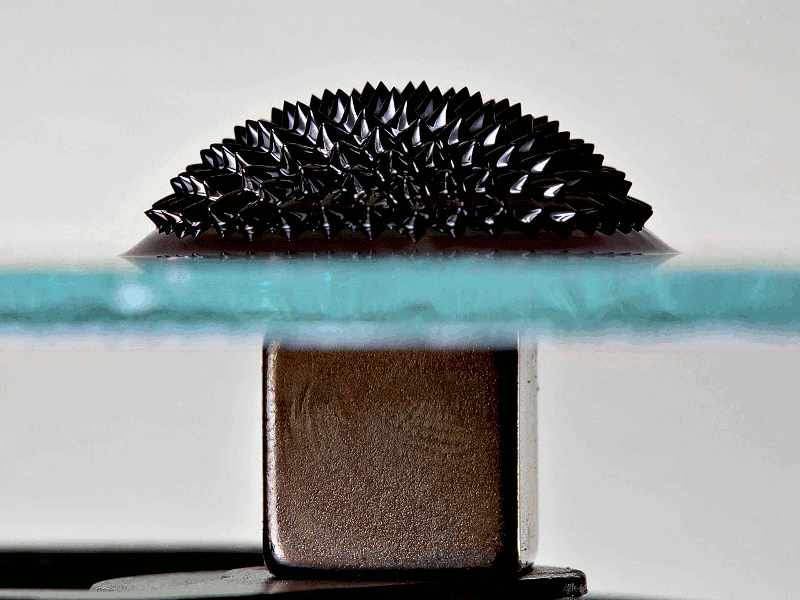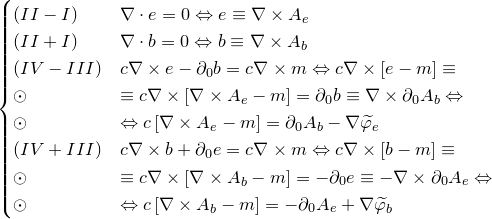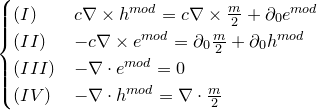Equivalent transformations of Maxwell equations
In many cases, the problems solved in electrodynamics are reduced to the separation of variables and running “fitted” finite differences on a supercomputer, but I am afraid that the “rigidity” of Maxwell's equations simply “ rips off ” the accuracy of calculations so that they cannot even be used for evaluation. The following are elementary transformations of Maxwell's equations and, as a result, a scheme that simplifies the calculations / description of the field, but unfortunately, not volume.
(The topic is purely technical, concerns only the issues of processing the data of calculations of electrodynamics, a lot of formulas.)

Further, only CGS units are used , for transferring to SI as a basis, one can take the Material from the Wikipedia "Maxwell Equations"
')
While stuffing this article, I encountered the first surprise (for a seed ...) of a microscopic system of equations.

reduce to the "continuity equation"



"The first part of myrlyzonsky ballet"





"The second part of the Myrleseon Ballet" The MÚNERA - GUZMÁN - Ansatz



[en] André Waser On The Notation of MAXWELL's Field Equations
"The third part of Myrlizon ballet"


Here the defect is almost not noticeable, but ... Find?
In a system with a Lorentz gauge or such, all the same come from the gradient, and with j = q v even there is no chance to build a consistent system (well, who will build the speed from a curl?). Hello to KED!
“Before apotheosis”






"Xfiles"



Lorenz force:
Pointing's Vector:
For the sake of expressing power functions through a single field, all this was started. Electrodynamics - DFTE in its pure form, see the textbook of 1958 “Lavrentiev MA, Shabat B.V. Methods of the theory of the function of a complex variable ”Chapter III Chapter“ Flat field and complex potential ”, the question is where to make thewaist logarithm.
Let's start with a simple question: “where does this field exist?”
- The Newtonian field is built on a “light cone” passing through the sensor (building a “current” requires matching several, ideally, a surface (a sensor in a parabola focus?), Which is the most difficult operation), there is no time on it, photons and “Close action”.
Time?
- The fields (not the field) on the light cone do not intersect, the elementary particles retain the sums of charges, from the beginning of time to the end (yes, you need to know what was and what will be, and bad infinity). Wave motion can be approximated by Newton polynomials.
Elementary particles?
- The logarithmic feature of the corresponding logarithm of a field approximated by a polynomial, if the proton is considered to move into the future, then all the positive particles are there, the negative ones are into the past, and the neutral ones are the interference of partons. [ru] Thanks for Lummore link
Polynomial?
- Consisting of products (RR k ), R k - the particle coordinate relative to the sensor, on the cone. Then we crush the space into space-time: (t - (RR k ) / c) + - (t + (RR k ) / c) i - for positive, and (t + (RR k ) / c) + - ( t - (RR k ) / c) i - for negative. Feynman, somehow, remembered that electrons are similar to each other because they are essentially one and the same electron. How, and for that, thanks to Feynman for returning the return wave to electrodynamics.
a small quote from here

(The topic is purely technical, concerns only the issues of processing the data of calculations of electrodynamics, a lot of formulas.)

Further, only CGS units are used , for transferring to SI as a basis, one can take the Material from the Wikipedia "Maxwell Equations"
')
While stuffing this article, I encountered the first surprise (for a seed ...) of a microscopic system of equations.

reduce to the "continuity equation"




"The first part of myrlyzonsky ballet"





"The second part of the Myrleseon Ballet" The MÚNERA - GUZMÁN - Ansatz



[en] André Waser On The Notation of MAXWELL's Field Equations
"The third part of Myrlizon ballet"


Here the defect is almost not noticeable, but ... Find?
In a system with a Lorentz gauge or such, all the same come from the gradient, and with j = q v even there is no chance to build a consistent system (well, who will build the speed from a curl?). Hello to KED!
“Before apotheosis”






"Xfiles"



Lorenz force:

Pointing's Vector:

For the sake of expressing power functions through a single field, all this was started. Electrodynamics - DFTE in its pure form, see the textbook of 1958 “Lavrentiev MA, Shabat B.V. Methods of the theory of the function of a complex variable ”Chapter III Chapter“ Flat field and complex potential ”, the question is where to make the
Let's start with a simple question: “where does this field exist?”
- The Newtonian field is built on a “light cone” passing through the sensor (building a “current” requires matching several, ideally, a surface (a sensor in a parabola focus?), Which is the most difficult operation), there is no time on it, photons and “Close action”.
Time?
- The fields (not the field) on the light cone do not intersect, the elementary particles retain the sums of charges, from the beginning of time to the end (yes, you need to know what was and what will be, and bad infinity). Wave motion can be approximated by Newton polynomials.
Elementary particles?
- The logarithmic feature of the corresponding logarithm of a field approximated by a polynomial, if the proton is considered to move into the future, then all the positive particles are there, the negative ones are into the past, and the neutral ones are the interference of partons. [ru] Thanks for Lummore link
Polynomial?
- Consisting of products (RR k ), R k - the particle coordinate relative to the sensor, on the cone. Then we crush the space into space-time: (t - (RR k ) / c) + - (t + (RR k ) / c) i - for positive, and (t + (RR k ) / c) + - ( t - (RR k ) / c) i - for negative. Feynman, somehow, remembered that electrons are similar to each other because they are essentially one and the same electron. How, and for that, thanks to Feynman for returning the return wave to electrodynamics.
a small quote from here
from the review
... Maxwell's theory, as said, transfers the center of attention from the charges and potentials of the conductors to the space between them. What value keeps the charge? ... For a number of Maxwell's followers, the charge often ceases to exist as a physical fact, turning into a mathematical symbol, a measure of the flow that permeates the surface surrounding the charge. In particular, far goes this way Poiting. According to his views, the surface of the conductor in general is such a surface, beyond which the electromagnetic field ends. There is no movement of electricity at an electric current; the only significant phenomenon in the current is that the magnetic energy present in the “current” field flows into the conductor in the direction normal to its surface, and, entering the conductor, turns into a new kind - into the well-known Joule heat ... Constant repetition of some the same “portions” of electricity in simple multiple relationships should have prompted the idea of the atomic structure of electricity. But no - for decades this fact has been interpreted as the property of matter to be charged with a certain amount of electricity, and not the property of electricity itself to appear in these constant quantities ...

Source: https://habr.com/ru/post/248267/
All Articles